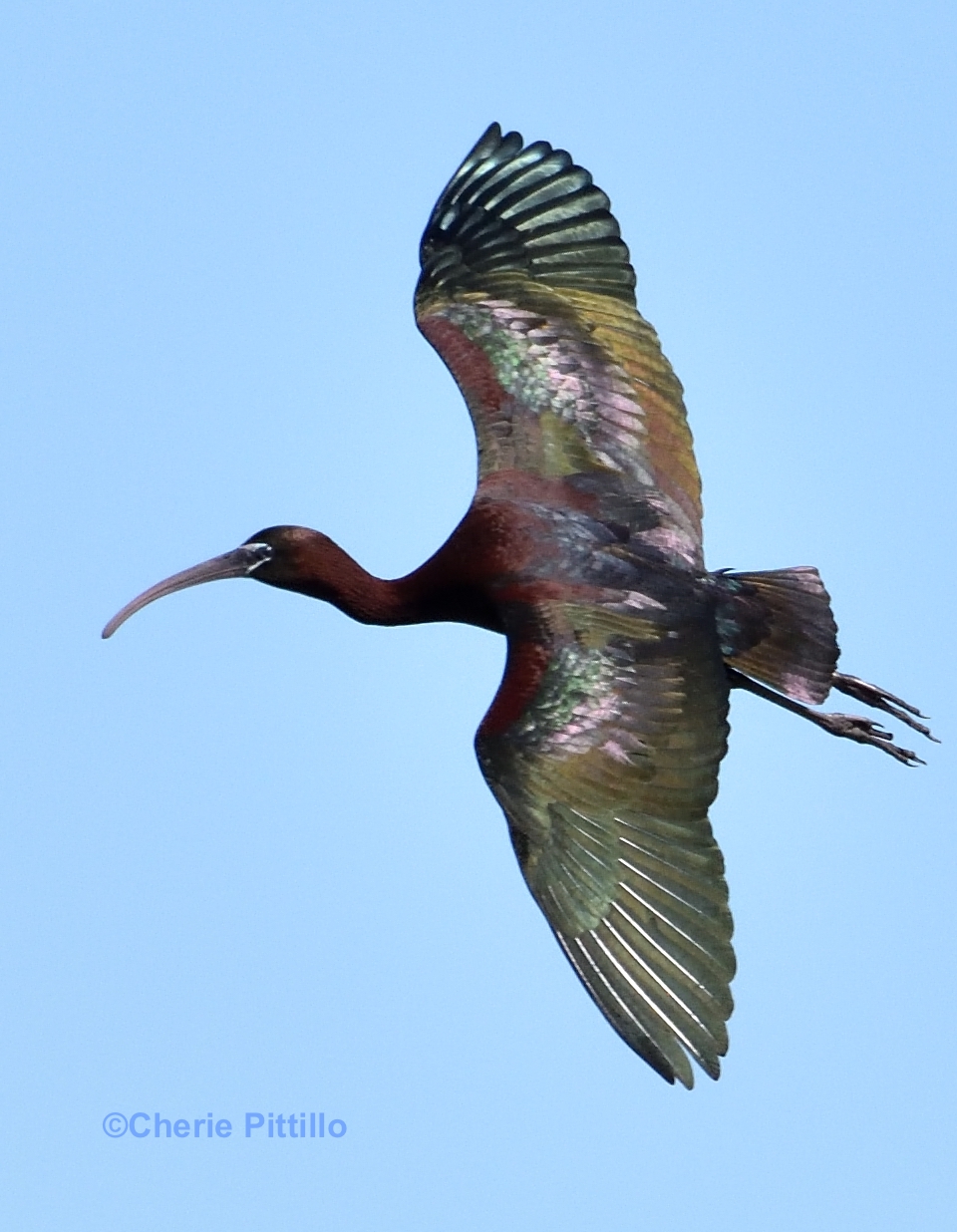GLOSSY IBIS, Plegadis falcinellus, Ibis Cara Oscura (Spanish)
Reflected sunlight illustrates the glossiness of this Glossy Ibis in flight like a darkened rainbow. From a distance it looks black referring to a common name of “black curlew” or “bronze curlew” in sunlight. Often confused with the White-faced Ibis, the Glossy Ibis lacks pale blue skin behind the eye during breeding season.

Glossy Ibis

Note the pale blue line doesn’t go behind the eye of the Glossy Ibis
How fortunate I saw this dark ibis in action at a mixed-species rookery to defend its stick-built platform nest nestled in shrubs. From my dis-advantage point, I couldn’t see the nest, but the two foot high Glossy Ibis rose to the occasion in defense when any egret, anhinga, or heron approached the nest. I’m always amazed at the proximity of wading bird nests to each other and how constant the nest protection. It’s like an invisible fence readily marks that line of “de-fence.”

Glossy Ibis threatens Black-crowned Night Heron near nest

After nest defense, Glossy Ibis settles down into nest below three Anhinga chicks

Hidden nest of Glossy Ibis among Anhinga nests (lower right corner
Although the Glossy Ibis is the most widespread ibis species in the world, it’s considered an understudied species. It lives on every continent except Antarctica primarily in brackish and freshwater wetlands. In the Yucatan peninsula it resides in the state of Campeche but is migratory in the other two states.

Adult Glossy Ibis breeding plumage

Non-breeding Glossy Ibis
Imagine my surprise to learn that other than mainly distribution and morphological research, many references state limited behavioral observations from 1913! Noted ornithologist, Arthur Bent, published the 1913 observations in 1926 and wrote: “The status of the glossy ibis, as a North American bird, is a puzzling problem, which it is difficult to solve with our present limited knowledge.”
But prior to that, in January, 1832 John James Audubon wrote a letter to his wife claiming he may have collected a new ibis in Florida. “The Glossy Ibis is of exceedingly rare occurrence in the United States, where it appears only at long and irregular intervals, like a wanderer who has lost his way…”
Other experts remark how it is a recent colonist in the 1880s to the Americas. (Evidently they didn’t research Audubon!) Supposedly it descended from European immigrants, settling along the Atlantic and Gulf coasts and reaching eastern Canada in 1986, a hundred years later. Transatlantic crossings still occur as a chick hatched in Spain in 2013 reached the Bermuda Airport in September. (Wonder if the tail wind helped?)
One of the reasons I included this information is to show the difficulty in a) ferreting out research, and b) deciphering who to believe. This happens with every column I share.
According to 1913 observations, the adult pair exhibit mutual cooing during courtship. Both species build the nest and the female mainly incubates the 3-4 eggs. A greeting ceremony of rubbing each other’s bills and cooing may last for fifteen minutes during nest relief between the parents and even until the young fledge. Meanwhile the parents add more sticks to double the nest size until the juveniles leave.

Glossy Ibis collects sticks to build platform nest in shrubs, trees, or on ground
Happily I did find research about that obvious feature, the decurved bill, used for probing mud to capture prey. The scientific name translates to “scythe” or “sickle.” Guess if it made a popping sound, it would be a pop-sickle.
The ibis is primarily a tactile feeder thanks to a specialized organ containing clusters of receptors located in the pits of the bone of the bill tip. This organ receives vibrations from moving prey and can determine pressures created by hard-shelled prey when the bill probes. Typically it forages in small flocks or with other wading birds in shallow water but it can submerge the head and/or take prey from the surface or chase its prey.

The Glossy Ibis decurved bill can probe in mud or other substrates

Sometimes the Glossy Ibis can submerge the bill in shallow water to find its prey

While foraging, Glossy Ibis may feed in small flocks or with other wading birds

About two feet tall, the Glossy Ibis is ‘knee-high to a grasshopper’ or an American White Pelican
This colonial species dines mainly on adult and larval insects, like grasshoppers, aquatic insect larvae, and a variety of crustaceans including mussels, clams, snails and especially crayfish. Plus it eats tadpoles, frogs, fish, lizards, and snakes. Yes, snakes. Along parts of the United States coast, parents capture and feed their chicks young venomous snakes called cottonmouth moccasins which seem to make up half their diet!

A special bill-tip organ helps the Glossy Ibis during foraging to locate prey
Due to the bill shape and its use, I didn’t expect this bird to feed also on rice and sorghum. As a grain feeder, it can usually pick up loose grains after harvest. Rice fields seem to have aided in recolonizing areas in Spain, Australia, and Cuba. (Puts a new meaning to “glossed over!)
Like the Glossy Ibis, nature is also widespread. Explore outdoors to uncover its secrets.
DISCLAIMER: References do not agree on details about this species:
Sal a Pajarear Yucatan, Birds & Reserves of the Yucatan Peninsula, Life Histories of North American Birds: Marsh Birds, The Birds of America, The original water-color paintings by John James Audubon for The Birds of America, Florida Bird Live, A Guide to the Birds of Mexico and Northern Central America, Sibley Guide to Bird Life and Behavior, Lives of North American Birds,
http://www.bioone.org/doi/abs/10.1525/auk.2009.09117
https://birdsna.org/Species-Account/bna/species/gloibi/introduction?login
https://www.hbw.com/species/glossy-ibis-plegadis-falcinellus
http://americanornithologypubs.org/doi/full/10.1525/auk.2009.09117
Cherie Pittillo, “nature inspired,” photographer and author, explores nature everywhere she goes. She’s identified 56 bird species in her Merida, Yucatan backyard view. Her monthly column features anecdotes about birding in Merida, Yucatan and also wildlife beyond the Yucatan.
Contact: [email protected] All rights reserved, ©Cherie Pittillo

